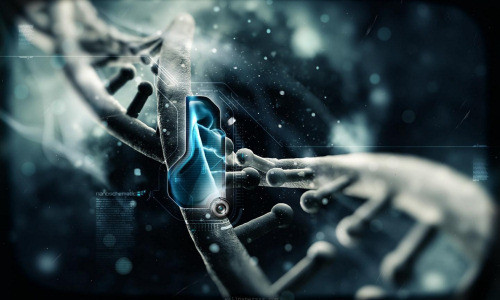New technology from MIT and Harvard can edit DNA at the genome scale, giving cells novel functions.
MIT and Harvard researchers have developed technologies that could be used to rewrite the genetic code of a living cell, allowing them to make large-scale edits to the cell’s genome. Such technology could enable scientists to design cells that build proteins not found in nature, or engineer bacteria that are resistant to any type of viral infection.
The technology, described in the July 15 issue of Science, can overwrite specific DNA sequences throughout the genome, similar to the find-and-replace function in word-processing programs. Using this approach, the researchers can make hundreds of targeted edits to the genome of E. coli, apparently without disrupting the cells’ function.
“We did get some skepticism from biologists early on,” says Peter Carr, senior research staff at MIT’s Lincoln Laboratory (and formerly of the MIT Media Lab), who is one of the paper’s lead authors. “When you’re making so many intentional changes to the genome, you might think something’s got to go wrong with that.”
The new paper is the result of a seven-year collaboration between researchers in the lab of Joseph Jacobson, associate professor in the Media Lab, and George Church, professor of genetics at Harvard Medical School. In addition to Carr, lead authors of the paper are Farren Isaacs, an assistant professor of molecular, cellular and developmental biology at Yale University, and Harris Wang, a research fellow at Harvard’s Wyss Institute for Biologically Inspired Engineering.
Editing DNA’s code
DNA consists of long strings of “letters” that code for specific amino acids. Every organism uses the same genetic code to translate those letters into amino acids, which are then strung together into proteins.
To make that translation, nearly all living cells use the same genetic code, which has 64 codons — three-letter DNA “words.” While most of them specify an amino acid, there are also a few codons that tell the cell when to stop adding amino acids to a protein chain. The MIT and Harvard researchers targeted one of these “stop” codons, which consists of the letters TAG. With just 314 occurrences, the TAG stop codon is the rarest in the E. coli genome, making it a prime target for replacement.
To make their edits, the researchers combined a technique they previously unveiled in 2009, called multiplex automated genome engineering (MAGE), with a new technology dubbed conjugative assembly genome engineering (CAGE).
MAGE, which has been called an “evolution machine” for its ability to accelerate targeted genetic change in living cells, locates specific DNA sequences and replaces them with a new sequence as the cell copies its DNA. This allows scientists to precisely control the types of genetic changes that occur in cells: The targets are replaced, while the rest of the genome is left untouched.
In this case, the researchers replaced the TAG codon with another stop codon, TAA, in living E. coli cells. To make the process more manageable, the researchers first used MAGE to engineer 32 strains of E. coli, each of which has 10 TAG codons replaced.
To combine those strains and eventually end up with one that has all 314 edits, the researchers then developed CAGE, which allows them to precisely control a naturally occurring process that bacteria use to exchange genetic material. One bacterium builds an extension to a neighboring cell, then passes a piece of genetic material — in this case, TAA codons — to its neighbor.
The researchers set up a playoff-like system in which each strain shares its DNA with one other strain. After the first round of CAGE, the researchers had 16 strains, each of which had double the number of TAG edits that it started with. Those 16 strains then went into a second round of CAGE, producing eight strains.
At this point, the researchers have four strains, each of which has about one-quarter of the possible TAG substitutions; they believe they are on track to produce the single combined strain with all 314 of the substitutions, Carr says.
The new paper represents a “giant step” toward the goal of replacing every instance of a specific codon, says Jef Boeke, professor of molecular biology and genetics at Johns Hopkins University. “This paper outlines several important technical improvements that allow the authors to combine a number of smaller engineered segments into larger ones,” he says.
‘Plug and play’
Because the alterations were done in living cells, the researchers have been able to monitor any potential harmful effects as they appear. Preliminary characterization suggests that the altered bacteria still behave normally, and can survive and reproduce.
Once all the TAG stop codons are deleted, the researchers’ next step is to delete the cell machinery that reads the TAG codon — freeing it up for a completely new purpose, such as encoding a novel amino acid. That kind of “plug-and-play” slot would give scientists great flexibility in designing cells that produce new proteins, Carr says.
By altering the genetic code, scientists could also engineer bacteria that are resistant to multiple viruses. In industries that cultivate bacteria, including pharmaceuticals and energy, viruses affect up to 20 percent of cultures, with a huge impact on productivity. However, those viruses can only infect a cell if the bacterial and viral genetic codes are the same.
Altering the genetic code of industrial bacteria could also create a “genetic firewall” that would prevent engineered bacteria from spreading their genes to natural bacteria in the environment, or from allowing such bacteria to survive in the wild, Carr says.
Story Source:
The above story is based on materials provided by MIT news, Anne Trafton.





